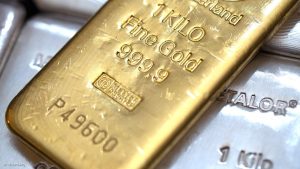Gold’s $4K Surge Steals Spotlight from S&P Highs
Gold may not see the explosive gains experienced in the past two years, but it still has the potential to deliver attractive returns moving forward

Quick overview
- XAU/USD is experiencing negative trading due to reduced demand from geopolitical easing and USD dip-buying pressure.
- The recent Israel-Hamas peace agreement has alleviated tensions, impacting gold's safe-haven appeal.
- Analysts suggest that while gold's explosive gains may not continue, significant potential for returns remains due to the Federal Reserve's rate-cut cycle.
- Gold's historical low correlation with stocks positions it as an effective hedge against economic downturns.
XAU/USD is trading negatively during the early European session on Thursday after failing to benefit from an intraday rebound near the $4,000 psychological mark.
A significant factor reducing demand for this safe-haven commodity is the Israel-Hamas agreement on the first phase of a peace deal, which has alleviated some geopolitical tensions.

The presence of some USD dip-buying is putting further pressure on the precious metal, while dovish expectations from the Federal Reserve (Fed) may help limit larger losses.
Gold has been a dominant force in the S&P 500 and broader markets, leading even the most committed gold supporters to question how much room for growth remains. Some analysts argue that the substantial gains seen over the last 24 months were driven by a unique combination of factors that are unlikely to align in the same way again.
The yellow metal appears to be in the early stages of a secular bull market that could push prices to much higher levels. Analysts believe that the rally in gold prices still holds significant potential now that key factors are starting to come into play. Surprisingly, this recent increase in gold prices has occurred despite its typical market drivers.
Looking ahead to the remainder of 2025 and beyond, three primary factors are expected to propel gold’s rise: the Federal Reserve’s rate-cut cycle, which began in September, serves as a fundamental tailwind and acts as a catalyst for ETF flows. Historically, lower interest rates have been crucial for supporting gold prices.
When risk-free interest rates are high, investors face a considerable opportunity cost, since gold is a non-yielding asset. Gold becomes more appealing when U.S. interest rates—and consequently, U.S. Treasury bond yields, often referred to as the global risk-free rate.
Extensive research conducted over the past 20 years (2003–2023) indicates a statistical correlation: for every 1% drop in real yields, there is a corresponding effect on gold prices.
Gold may not see the explosive gains experienced in the past two years, but it still has the potential to deliver attractive returns moving forward. Gold has historically shown a low to negative correlation with stocks during prolonged market sell-offs, making it one of the most effective hedges against economic slowdowns.
- Check out our free forex signals
- Follow the top economic events on FX Leaders economic calendar
- Trade better, discover more Forex Trading Strategies
- Open a FREE Trading Account